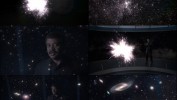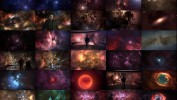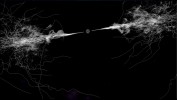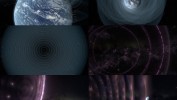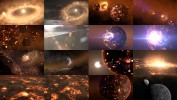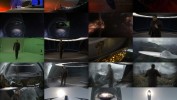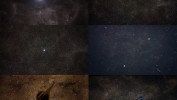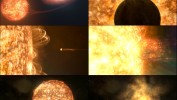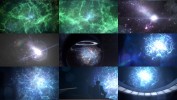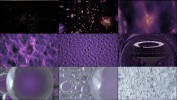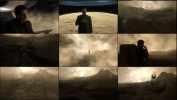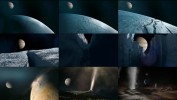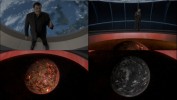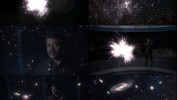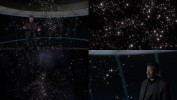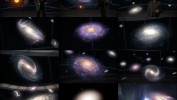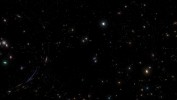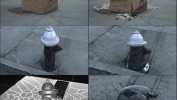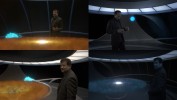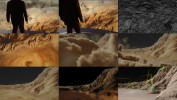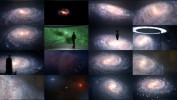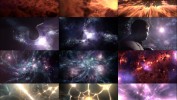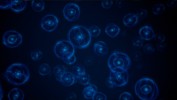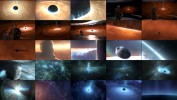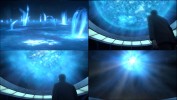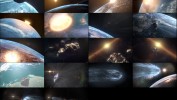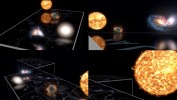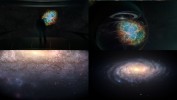Cosmos: A SpaceTime Odyssey
DIRECTOR : Brannon Braga
PRODUCTION : Cosmos Studios / Fuzzy Door / National Geographic
CREATED BY : Ann Druyan / Steven Soter
VFX SUPERVISOR : Dominique Vidal
VFX PRODUCER : Yann Suquet / Marguerite Moreau de Lizoreux
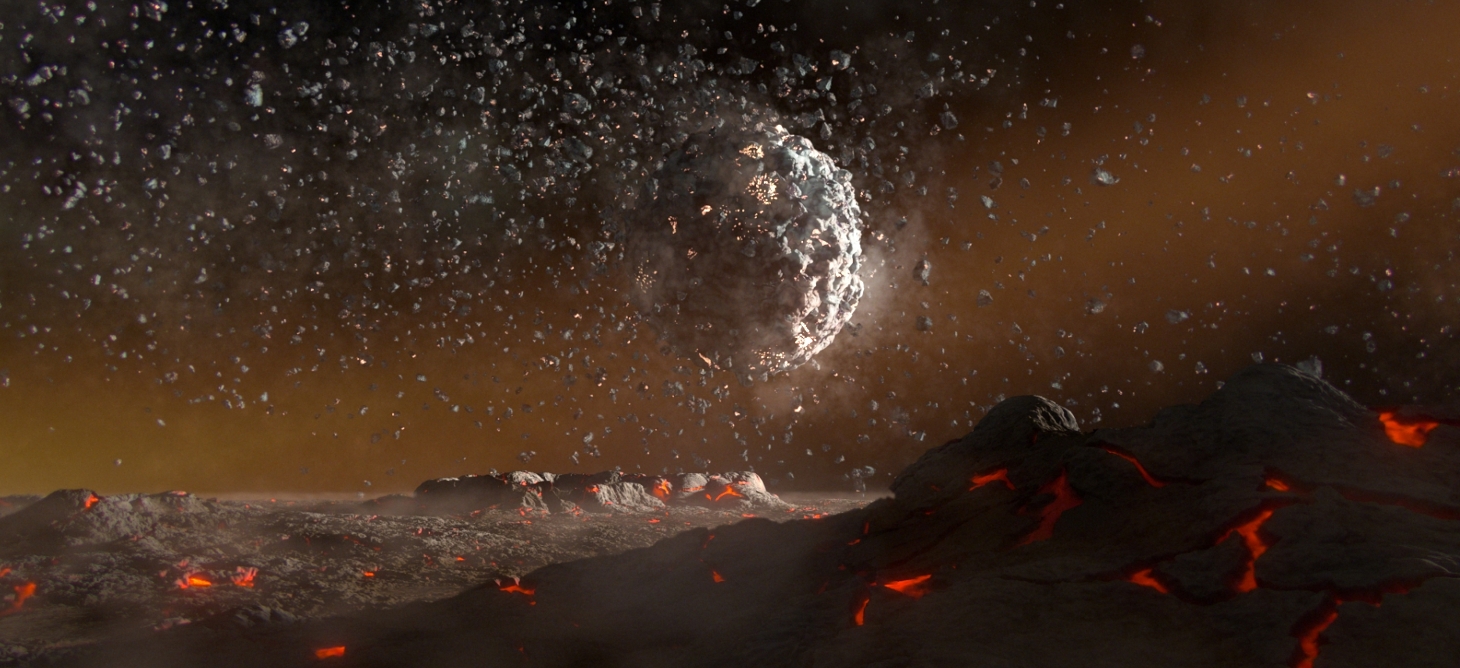
MAKING OF : Charles Labriet
MUSIC : Darkside - A3
NUMBER OF SHOTS : 270
Awards
13th Visual Effects Society Awards:
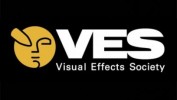 “Outstanding Effects Simulations in a Commercial, Broadcast Program, or Video Game”
“Outstanding Effects Simulations in a Commercial, Broadcast Program, or Video Game”1st Digital Creation Genie Awards:
 Dominique Vidal - "Best VFX supervisor" (TV Drama)
Dominique Vidal - "Best VFX supervisor" (TV Drama)
Production notes
COSMOS A Spacetime Odyssey
Ann Druyan & Brannon Braga
FOX – 2013/2014
Number of VFX shots: 260
Supervisor : Dominique Vidal
Producer : Yann Suquet / Marguerite Moreau de Lizoreux
Production schedule: October 2013 to April 2014
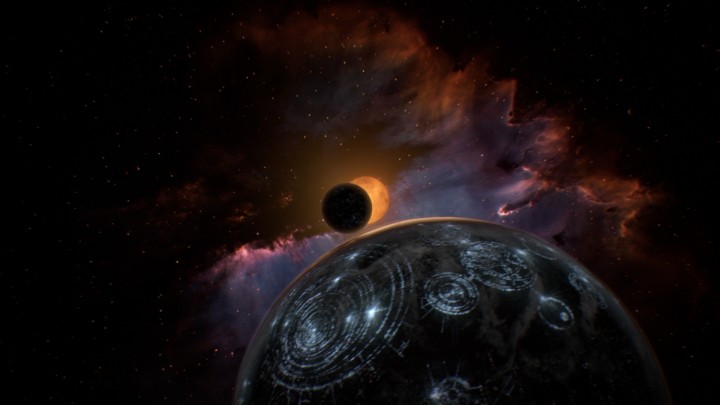
Sequences worked on by BUF
BUF worked on 12 of the 13 episodes of COSMOS, A space-time Odyssey (episode 1 and episodes 3 to 13) and made a total of 260 VFX shots for the series which represent more than an hour of VFX.
BUF's work was essentially concentrated on the challenge of space/universe representation : rides and travels into space, representation of events or physical phenomenons, in the past or in the future of the universe, such as black hole, nebula, dark matter, comet collisions, universe expansion... and many others.
As COSMOS' distinguishing feature is the Ship Of The Imagination (aka SOTI), BUF also worked on many shots with SOTI : animation, integration of the plate shot on the real set or on green screen with Neil DeGrasse Tyson on the 3D ship etc...

ALIEN UNIVERSE – 16 shots
The journey of SOTI takes the audience through various alien universes, as it jumps from one black hole to another, or when we are looking at future or distant places. Because of their unknown nature, there was less scientific accuracy needed on these shots. This created an opportunity for BUF to provide a more creative representation of space : cloudy nebula designed in a cathedral of smoke, tripods green nebulae, bubbly universe made of fractal spheres, gigantic electric arcs, or psychedelic full-blown roller coaster ride down the infinite regress.
ATOMES – 1 shot
BUF had to make a hyper macro view of a stellar nursery cloud containing atoms of iron, oxygen and carbon. This was a challenging shot, more in a representation and artistic point of view than technically wise. How show what could not be shot due to it's infinitesimally small size, yet still make it understandable and scientifically correct?
We tried to enhance the randomness of the electrons, correctly placed on their quantum orbit around the atom nucleus, and using symbolic colors to distinguish them.
BLACK HOLE – 40 shots
For this long sequence, we had to show the journey of SOTI around and inside a black hole. The challenge here was to render visually this kind of place of the universe where space, time and physical laws are dramatically different. The black hole asset essentially consists of a dust accretion disk made of particles and procedural textures, of a blue energy column made of ejected particles, a ring of violent particle activity on the event horizon (dynamic fluid simulation), and finally of a black sphere in the center (the simplest asset of all). Many tests were made for the event horizon aspect, where particles approach the speed of light, but also where time is paradoxically slowed down to zero.
For all the shots of Neil inside SOTI during this black hole crossing, we created a special persistence treatment to the foreground plate, in order to express the time distortion. For each frame, we mixed up to 30 different frames, randomly picked around it, in the future and the past interval.
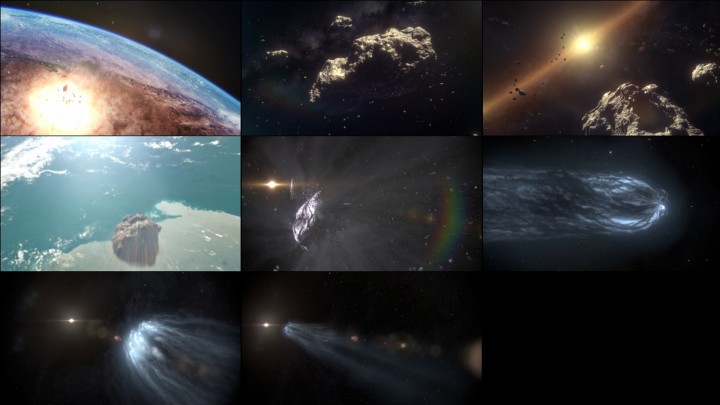
COMETS – 16 shots
Various sequences involved the creation of comets, traveling through space with their gaseous tail (in one shot, we are inside the trail), or falling and impacting the Earth. We used procedural displacement mapping for the rendering of the comet itself, procedural volumetric shaders for its vapor tail, and some dynamic simulations for the impacts.
COSMIC CALENDAR – 8 shots
The Cosmos production asked BUF to provide several assets for a sequence of the future Cosmic Calendar. We made 4 elements (future Sun, collision between Andromeda galaxy and the Milky Way, an elliptical galaxy and a generic nebula) and computed for 8 shots that another vendor (Atomic Fiction) integrated in the final compositing.
CRAB NEBULA – 4 shots
The Crab Nebula is one of the most beautiful cosmic objects and the idea of building it was a very exciting challenge. We started with modeling the global exterior shape of the nebula and used it to generate particles, defining their color and density by using a photo of the nebula mapped on the model. This sponge/lace structure of smoke was obtained with several layers of particles generated on concentric onion shells.
A long shot of this sequence (more than 1 min) shows the position of the Crab Nebula in the Milky Way, its distance from our Solar System, and then pulls back to show the local galaxies cluster.
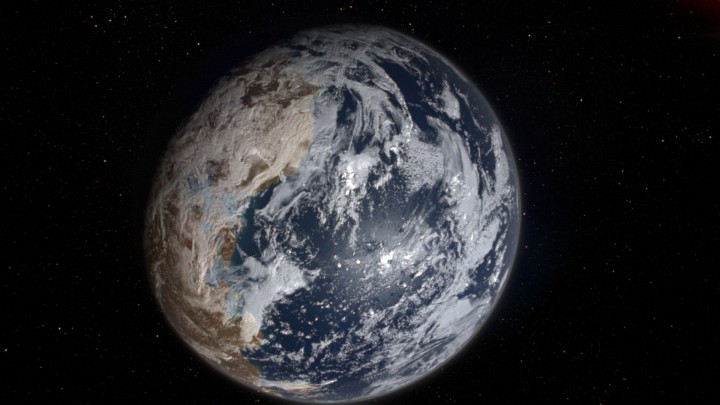
EARTH – 5 shots
BUF created some earth views, with various assets depending on its age : proto volcanic earth, primordial moon-like earth, Pangea earth, current earth.
EXPANDING UNIVERSES – 9 shots
For this hologram sequence in SOTI, BUF animated almost the entire Universe to explore future scenarios. To simulate the Big Bang, the Big Crunch and the infinite expansion theories, we started from the current state of the Universe, large cluster of galaxies built from a fractal tree distribution with thousands of particles textured with galaxies' photos.
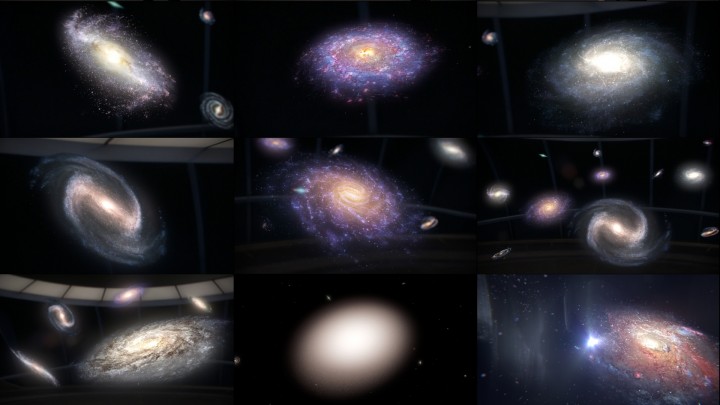
GALAXIES – 7 shots
In addition to the Milky Way and Andromeda, BUF was asked to create several assets of galaxies that could be animated to show some internal motion of stars and dust during a hologram sequence in SOTI. After a casting of 8 interesting galaxies, we built assets using a sandwich of textured cards and a bunch of particle stars. We also created an asset of a giant elliptical galaxy.
GRAVITATIONAL LENS – 2 shots
To illustrate the cosmological phenomenon of gravitational distortion that bends the light rays near the massive galaxy clusters, we had to create a specific camera lens shader simulating a spatial distortion. For our full 3D galaxy cluster, we used as reference the astrophotographies of the Coma Galaxy cluster.
GRAVITY – 2 shots
Before a sequence about the Black Hole, Neil de Grasse Tyson makes a little detour by New York to explain the concept of gravity force. We had to create a couple of examples of hyper gravity environment and apply them to ordinary objects.
In the first shot, a cardboard box falls on the pavement and is crushed under a 3 G gravity force. We animated the box using a cloth simulation. To obtain a satisfying result, all the main creases were designed on the box model.
We added some polystyrene chips and glass debris that are ejected when the box breaks up. The idea was to enhance the unusual gravity by a strange behavior on those very light elements that fall curtly on the ground and squeeze.
In the second shot, a fire hydrant suffers several thousands G of gravity. After numerous simulation tests and different technical approaches, we chose to use a high viscosity liquid simulation. After having built the fire hydrant mesh with the correct thickness inside it (we used blue prints), we voxelized it and filled the plain parts with particles. Then we made a liquid dynamic simulation, increasing the gravity force during the shot. The resulted behavior was similar to a viscous toothpaste. We then used this set of animated particles to warp a well refined polygon mesh.
The cracked sidewalk was designed separately and then rigged to a grid animated with a cloth simulation, reacting to the fire hydrant squashing.
HOLOGRAM – 6 shots
For some of Neal's explanations in SOTI, we had to provide some hologram animations showing the behavior of a blue giant star and its black hole companion.
JUPITER – 2 shots
For an overview sequence presenting the Solar System, BUF had to make 2 shots of the Jupiter planet, seen near and inside the Great Red Spot, aka Jupiter's Eye. To build this gigantic vortex with that is the size of 3 earths, we decided to see it as canyons of clouds, almost solid at this scale. To ease the process, we chose to work with procedural modeling, and created special manipulation tools to design and animate the huge cyclonic shapes. A procedural displacement texture comes at the end to add thin details. A special shader was created to simulate the cloudy nature of the model, using translucency. Upon this model, we designed many paths flowing along the canyon walls to lead the particles of smoke.
The ground, a plain of clouds, was built using several satellite photos of Earth's cyclones in multiple transparency layers, animated in
MILKY WAY – 23 shots
BUF created a complex asset of the Milky Way that was used for numerous shots. Built from a spiral fractal tree, many layers were generated : various size of stars and star clusters, clouds and dust, pink nebulae, hot heart made of dust particles and dark tendrils based on hair shaders textured with cosmic clouds. For some shots showing a time-lapse of our galaxy during millions of years, this asset was animated with a procedural coiling that simulates the physical laws revealing the dark matter.
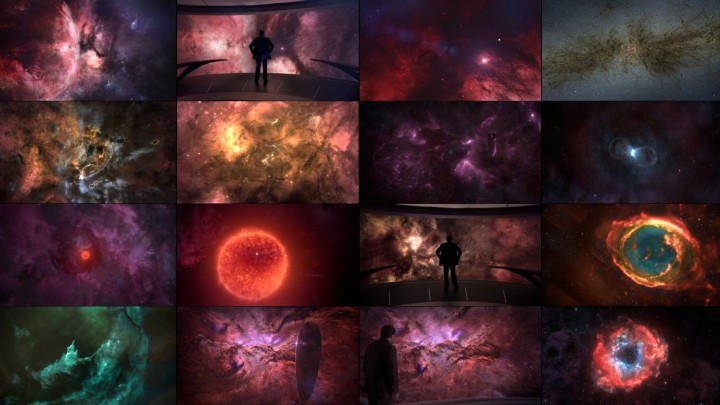
NEBULA – 17 shots
This category includes many different shots with various purposes : some of them are showing specific cosmic places (the Eta Carina nebula, the Crab nebula, the Emission nebula, the Rosette nebula, the Orion nebula) and others are more generic nebulae, cloudy colorful cosmic postcards. Based on astrophotography references, the challenge here was to dimentionalize and build assets in order to travel around or through the nebulae. Various approaches were used depending on the shot, from simple cards textures, smoke particles, sprites, metaballs, hair shaders, procedural shaders. We were very careful to optimize the rendering cost, specially for those using volumetric shaders. For example, the journey into the Eta Carina nebula is a 2.5 minutes shot, so a rendering cost of 10 minutes per frame will imply 23 days of computing time !
PULSAR – 2 shots
This representation of a pulsar needed some fluid simulations and a hair shader to simulate the magnetic distortions.
RADAR SIGNAL – 3 shots
This sequence illustrates how humanity is emitting radio signals through space, symbolized with bubbles that are spread out and reach the neighboring stars. We also made an hypothetical alien signal (based on strange attractor textures), that crosses the trajectory of the Earth.
STARFIELD – 6 shots
To have parallax in some starfield shots, we generated some volume filled with particle stars, paying special attention to obtain a natural distribution, and analyzing various astrophotographies to find the right density of stars and color variations.
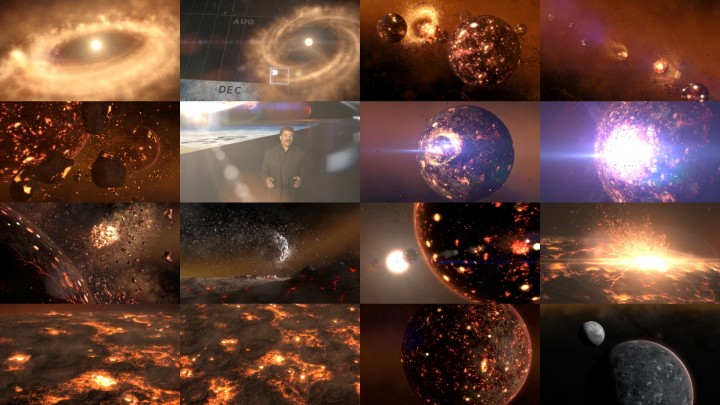
SOLAR SYSTEM CREATION – 12 shots
The solar system genesis sequences awarded to BUF represented very challenging shots, full of gigantic events, proto planets and asteroids colliding with each other or being bombarded with comets, birth of the moon, in the cosmic landscape of the dust and smoke primordial accretion disc. A bank of generic asteroid collisions (dynamic simulations) was prepared. A special tool was written to allow us to control the density of comets' impacts on planets, with automatic reverse animation of the comet. For the time-lapse of the moon aggregation, we created a procedural reverse animation, ejecting particles from a sphere filled with debris. For the biggest collisions, we used a liquid simulation dressed with incandescent debris, that fit better with the scale.
SOTI – 14 shots
Many shots involve the Spaceship Of The Imagination because the production wanted it to be the visual signature of the Cosmos series. The reflective ship was animated flying in various environments, and when Neil was visible in the shot, we composed a CGI SOTI around the shot set. At the end of the production, the client needed to re-shoot some additional sequences for some episodes, with Neil speaking in the spaceship. The problem was that the set did not still exist at this time, several months after the end of the main shooting. We were asked to recreate in CGI the interior of SOTI and compose Neil shot on a green screen. In one of those shots, we created a complex extension set, with the camera turning around Neil, inside and outside of SOTI, in a full CGI landscape of rice paddy fields.
BUF had the chance to be in charge of two important SOTI's shots : the first apparition of the ship in a long shot, time-lapse of a sunset upon the sea finishing by its takeoff with Neil, and its last takeoff in the end of the episode 13, on the same cliff, showing the empty ship leaving the Earth.
SUN and RED GIANT – 12 shots
We created a sun asset used to illustrate various sequences of the future and past. The Sun, mapped with animated procedural textures, is dressed with the typical tendrils of ejected gas, built from hair curves. In a sequence about the end of the Sun, we animated its growth and the destruction of Mercury and Venus, using fluid simulations. We also made some shots showing a red giant star, shedding a river of incandescent gas onto its white dwarf companion.
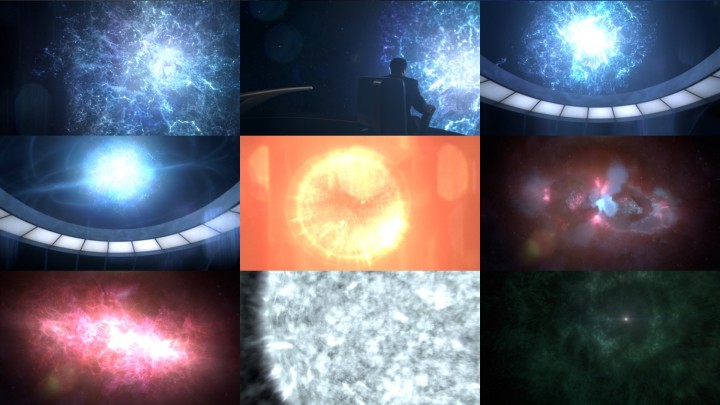
SUPERNOVAE – 17 shots
To create the massive supernovae explosions shots, we started to study some nebulae in the final state of a gigantic fluid explosion. So we created several dynamic simulations, mixed and retimed them in order to finish in a similar shape to some nebulae references, such as the Crab Nebula. Then we made a subtle morph to mix the fluid simulation and actual photos of the nebula. Because most of the explosion shots were quite long (often more than 15 seconds), we had to choreograph various events to keep them violent, interesting and spectacular to see all throughout the shot. We used an initial flash of light, a blast, the ejection on material through space coming from fluid simulation, secondary explosions supposed to be coming from electromagnetic echos, and subtle apparition of nebula and smoke structures.
UNIVERSE and GALAXIES CLUSTER – 9 shots
This category of shots encompasses some sequences showing the Universe from a scale that reaches the limit of the visible universe.
We are beginning the shot at the scale of the Milky Way and the camera pulls back to embrace the surrounding galaxies cluster at 100000 times wider scale. All the galaxies of this cluster were built as fruits of a complex tree. Each branch of this tree is the trajectory of particles in an explosion simulation. The resulting structure of this process provides a “quasistatic” state : the set of galaxies seems to be randomly distributed in space, but a subtle dynamic structure can be perceived.
The camera continues to pull out, showing wider set of galaxies clusters to reach the limit of the visible universe, end of our cosmic address.
At this scale, we decided to represent the Universe as a fractal structure colored by the density of the galaxies. This structure was created using several layers of fractal sponge textures, and these layers were used to generate the density of galaxies.
Another challenge here was to make, in a single shot, a 3D camera journey that would cover such a huge scale change. In most of computer graphics softwares, one cannot animate a camera in a scene from 1 to 10 power 26 meters. So we had to create an exponential movement for the camera that allowed us to interlock different scenes as “Russian dolls”.
There is also one shot about the multiverse theory, showing thousands of various universes as drops of water in an huge waterfall. Procedural textures were used to generate the universes, inside reflective spheres that were animated using a liquid simulation.
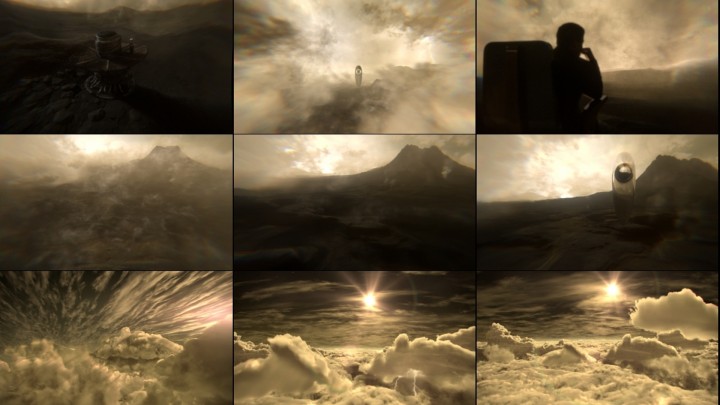
VENUS – 24 shots
BUF created a complex environment of the Venus planet, from the space point of view, from the satellite altitude, at the high atmosphere level, with the tormented sea of sulfur dioxide clouds, and from the SOTI flight over the cloudy landscape until reaching the rusting decomposing hulk of the Soviet Venera 13 spacecraft.
The challenge here was to build this environment using very few reference images, as only a couple of photos were taken by the Russian satellite after its landing before dying quickly in this hellish place. So we had to match these well-known references of a ground and volcanic close up, and imagine the rest of the landscape. We built a vast smooth and volcanic surface, using various earth volcano or moon crater height maps. The biggest challenge was to make the audience feel the terrible Venusian atmosphere, made of dense carbon dioxide, with an atmospheric pressure 92 times the Earth's and temperature of at least 460 °C. So we designed various atmospheric layers (clouds, fog, sulfuric gas chimney) to reduce the visibility. To render the high pressure, we added a strong lens distortion with extreme chromatic aberrations, as if the scene was shot through the porthole of a submarine. A heat wave effect was added at the end to render this infernal climate.
VOYAGER – 5 shots
A part of the last episode is dedicated to the Voyager 1 space probe. BUF was asked to create some shots showing some of the wonders that the probe discovered on Jupiter's and Neptune's moons : volcano eruption on Io, ride in the icy canyon of Europa, flight over the Triton's surface with its nitrogen geysers.



